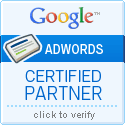Here are some interesting tidbits about Google AdWords Display Network advertising that I have gleaned from a recent Google sponsored seminar.
- Adding Display to a search campaign can increase brand recall by 124%.
- Use of Display Network advertising can increase purchase intent by 31%. Nearly 4 in 10 people will see your Display Network ad and then do a Google search on your company or product and then visit your website.
- After seeing a Display Network ad customers are 140% more likely to click on an organic link.
- Display Network advertising combined with search advertising increases the likelihood of a visit by 27%.
- Display Network advertising cost per acquisition (CPA) costs are on the average 35% less than the CPA of text advertising in the Display Network.
Pretty powerful statistics! Many of our clients supplement their Search Network advertising with Display Network advertising and reap strong additional exposure. Google has long said that sponsored advertising should be part of an overall online marketing plan and that sponsored exposure helps to feed unpaid search traffic.
Make sure to review our AdWords account management pricing if you are looking for a savvy expert to help you with Google AdWords search advertising.


